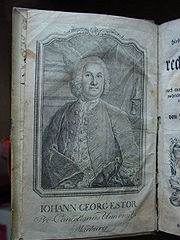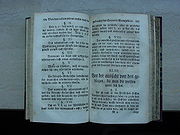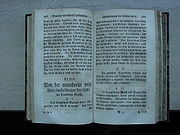
Johann Georg Estor
Encyclopedia

Germany
Germany , officially the Federal Republic of Germany , is a federal parliamentary republic in Europe. The country consists of 16 states while the capital and largest city is Berlin. Germany covers an area of 357,021 km2 and has a largely temperate seasonal climate...
theorist of public law
Public law
Public law is a theory of law governing the relationship between individuals and the state. Under this theory, constitutional law, administrative law and criminal law are sub-divisions of public law...
, historian and book collector. To his opinion the Roman Law is strange to the original German law-culture and must be considered as a foreign body.
Life
Estor was born in Schweinsberg (now part of StadtallendorfStadtallendorf
Stadtallendorf is a town in Marburg-Biedenkopf, Hesse, Germany, which lies about east of Marburg.- Location :Under the German system of Naturräume, Stadtallendorf lies in the West Hesse Depression Zone which is divided into basins and ridges...
, Hesse
Hesse
Hesse or Hessia is both a cultural region of Germany and the name of an individual German state.* The cultural region of Hesse includes both the State of Hesse and the area known as Rhenish Hesse in the neighbouring Rhineland-Palatinate state...
) and educated at the universities of Gießen
University of Giessen
The University of Giessen is officially called the Justus Liebig University Giessen after its most famous faculty member, Justus von Liebig, the founder of modern agricultural chemistry and inventor of artificial fertiliser.-History:The University of Gießen is among the oldest institutions of...
, Halle
University of Halle-Wittenberg
The Martin Luther University of Halle-Wittenberg , also referred to as MLU, is a public, research-oriented university in the cities of Halle and Wittenberg within Saxony-Anhalt, Germany...
, and Jena. He became professor of history and law first in Giessen, then in Jena. He moved to the University of Marburg in 1742. As professor in Giessen he learned natural history
Natural history
Natural history is the scientific research of plants or animals, leaning more towards observational rather than experimental methods of study, and encompasses more research published in magazines than in academic journals. Grouped among the natural sciences, natural history is the systematic study...
from his colleague Joahnn Melchior Verdrieß and became national geographer of the county of Hessen-Darmstadt
Darmstadt
Darmstadt is a city in the Bundesland of Hesse in Germany, located in the southern part of the Rhine Main Area.The sandy soils in the Darmstadt area, ill-suited for agriculture in times before industrial fertilisation, prevented any larger settlement from developing, until the city became the seat...
. In this time (around 1730) he came in contact with the famous geographer and physicist Johann Jakob Scheuchzer
Johann Jakob Scheuchzer
Johann Jakob Scheuchzer was a Swiss scholar born at Zürich.thumb|Herbarium deluvianumthumb|Zürich, Zwingli-Platz : Former home of Konrad von Mure and the house, where Johann Jakob Scheuchzer was bornthumb|Memorial plate-Career:The son of the senior town physician of Zürich, he received his...
.
Estor died in Marburg
Marburg
Marburg is a city in the state of Hesse, Germany, on the River Lahn. It is the main town of the Marburg-Biedenkopf district and its population, as of March 2010, was 79,911.- Founding and early history :...
in 1773, and was buried in his native Schweinsberg.
Work
The reason for Estor's aversion to the Roman Law is certainly his strong democratic inclination. In his early work Auserlesene kleine Schrifften there are several articles by himself and by other authors in which it is proven that the bondage of the peasants, which was in practise at his time, meant nothing more or less than slavery. One article deals with the fate and status of the slaves in ancient Rome and here parallels become evident.One of his most impressive works is Freiheit der teutschen Kirchen, where he describes the constant struggle between the Roman-German emperors and the popes since the Pope Gregory VII
Pope Gregory VII
Pope St. Gregory VII , born Hildebrand of Sovana , was Pope from April 22, 1073, until his death. One of the great reforming popes, he is perhaps best known for the part he played in the Investiture Controversy, his dispute with Henry IV, Holy Roman Emperor affirming the primacy of the papal...
. in the 11th century. In contrast to the popes the Roman-German emperors had no absolute power and the highest authority in the Holy Roman Empire
Holy Roman Empire
The Holy Roman Empire was a realm that existed from 962 to 1806 in Central Europe.It was ruled by the Holy Roman Emperor. Its character changed during the Middle Ages and the Early Modern period, when the power of the emperor gradually weakened in favour of the princes...
was not the emperor, the Kaiser, but the Reichsversammlung (Imperial Assembly), especially its most prominent members, the "Kurfürsten" (Electors) whose task was to elect the Kaiser. So the constitution of the Holy Roman Empire was democratic in a wider sense in contrary to the ancient Roman Empire, which was autocratic and where the princeps or Imperator Augustus possessed absolute power.
Estor illustrates this fact in "Neue kleine Schriften", Vol. 1 page 526 by describing the controversy about the Chapter 5 of the "Aurea Bulla", the constitution of the Holy Roman Empire. A large number of public law teachers of Estor's time, who were adherents of the Roman Law, thought that the authors of this constitution must have been insane, because this chapter deals with the case, when the Kaiser is discharged and is going to be accused of a crime. These romanists thought that the impeachment of an emperor had to be considered as a contradictio in adiecto, a contradiction in itself. But to Estor's point of view this chapter 5 was typical for the democratic character of the Holy Roman Empire and for the role of the Kaiser as the first Representative of the Reichsversammlung.
Very interesting is, what Estor says in "Freiheit der teutschen Kirchen" about Pope Gregory VII
Pope Gregory VII
Pope St. Gregory VII , born Hildebrand of Sovana , was Pope from April 22, 1073, until his death. One of the great reforming popes, he is perhaps best known for the part he played in the Investiture Controversy, his dispute with Henry IV, Holy Roman Emperor affirming the primacy of the papal...
. Contrary to the legend, that this powerful pope stemmed from the noble family Aldobrandeschi, Estor claims, that he was the son of a blacksmith in Saona in the Italian county of Toscana and that his full name was Hildebrand Bonizi. Apparently he was completely different from his father, a small and tiny person. His father forced him in his youth to cut wood for the fire, which Hildebrand hated as hell. So he decided to become a prominent and powerful person. In the Germany of the 11th century he was called later "Pabst Hildebrand Höllenbrand" (Hildebrand Hellfire). Estors version of Hildebrands origin is much more probable than the legend mentioned above, because Estors arguments are based on a whole library, as is mentioned in the foreword of his "Freiheit ..".
Discovery of the Sprites (lightning)
In the second volume of his "neue kleine Schriften", pages 195/6, there is a little note, in which Estor says that he had explored the landscapes of Hessen-DarmstadtDarmstadt
Darmstadt is a city in the Bundesland of Hesse in Germany, located in the southern part of the Rhine Main Area.The sandy soils in the Darmstadt area, ill-suited for agriculture in times before industrial fertilisation, prevented any larger settlement from developing, until the city became the seat...
on horseback or walking to accomplish a book about the national geography of this county. This was in the years around 1730. His teachers Verdrieß and Johann Jakob Scheuchzer
Johann Jakob Scheuchzer
Johann Jakob Scheuchzer was a Swiss scholar born at Zürich.thumb|Herbarium deluvianumthumb|Zürich, Zwingli-Platz : Former home of Konrad von Mure and the house, where Johann Jakob Scheuchzer was bornthumb|Memorial plate-Career:The son of the senior town physician of Zürich, he received his...
had given him a hint, to make observations "coelo tristi" (in a sad sky).


Vogelsberg
Vogelsberg is a municipality in the Sömmerda district of Thuringia, Germany....
near Burgharts, called "the saddle", through a thundercloud. In the middle of the cloud he felt little water droplets on his skin like dew. And as he had reached the top of the mountain, he saw the blue sky above him and the cloud beneath like a white sea, from which flashes mounted as well directly up into the sky (sprite (lightning)
Sprite (lightning)
Sprites are large-scale electrical discharges that occur high above thunderstorm clouds, or cumulonimbus, giving rise to a quite varied range of visual shapes flickering in the night sky. They are triggered by the discharges of positive lightning between an underlying thundercloud and the...
) and shot down to the earth.

